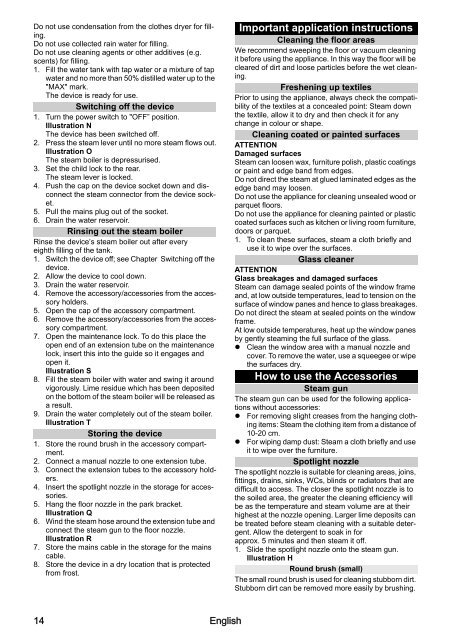You also want an ePaper? Increase the reach of your titles
YUMPU automatically turns print PDFs into web optimized ePapers that Google loves.
Do not use condensation from the clothes dryer for filling.<br />
Do not use collected rain water for filling.<br />
Do not use cleaning agents or other additives (e.g.<br />
scents) for filling.<br />
1. Fill the water tank with tap water or a mixture of tap<br />
water and no more than 50% distilled water up to the<br />
"MAX" mark.<br />
The device is ready for use.<br />
Switching off the device<br />
1. Turn the power switch to "OFF” position.<br />
Illustration N<br />
The device has been switched off.<br />
2. Press the steam lever until no more steam flows out.<br />
Illustration O<br />
The steam boiler is depressurised.<br />
3. Set the child lock to the rear.<br />
The steam lever is locked.<br />
4. Push the cap on the device socket down and disconnect<br />
the steam connector from the device socket.<br />
5. Pull the mains plug out of the socket.<br />
6. Drain the water reservoir.<br />
Rinsing out the steam boiler<br />
Rinse the device’s steam boiler out after every<br />
eighth filling of the tank.<br />
1. Switch the device off; see Chapter Switching off the<br />
device.<br />
2. Allow the device to cool down.<br />
3. Drain the water reservoir.<br />
4. Remove the accessory/accessories from the accessory<br />
holders.<br />
5. Open the cap of the accessory compartment.<br />
6. Remove the accessory/accessories from the accessory<br />
compartment.<br />
7. Open the maintenance lock. To do this place the<br />
open end of an extension tube on the maintenance<br />
lock, insert this into the guide so it engages and<br />
open it.<br />
Illustration S<br />
8. Fill the steam boiler with water and swing it around<br />
vigorously. Lime residue which has been deposited<br />
on the bottom of the steam boiler will be released as<br />
a result.<br />
9. Drain the water completely out of the steam boiler.<br />
Illustration T<br />
Storing the device<br />
1. Store the round brush in the accessory compartment.<br />
2. Connect a manual nozzle to one extension tube.<br />
3. Connect the extension tubes to the accessory holders.<br />
4. Insert the spotlight nozzle in the storage for accessories.<br />
5. Hang the floor nozzle in the park bracket.<br />
Illustration Q<br />
6. Wind the steam hose around the extension tube and<br />
connect the steam gun to the floor nozzle.<br />
Illustration R<br />
7. Store the mains cable in the storage for the mains<br />
cable.<br />
8. Store the device in a dry location that is protected<br />
from frost.<br />
Important application instructions<br />
Cleaning the floor areas<br />
We recommend sweeping the floor or vacuum cleaning<br />
it before using the appliance. In this way the floor will be<br />
cleared of dirt and loose particles before the wet cleaning.<br />
Freshening up textiles<br />
Prior to using the appliance, always check the compatibility<br />
of the textiles at a concealed point: Steam down<br />
the textile, allow it to dry and then check it for any<br />
change in colour or shape.<br />
Cleaning coated or painted surfaces<br />
ATTENTION<br />
Damaged surfaces<br />
Steam can loosen wax, furniture polish, plastic coatings<br />
or paint and edge band from edges.<br />
Do not direct the steam at glued laminated edges as the<br />
edge band may loosen.<br />
Do not use the appliance for cleaning unsealed wood or<br />
parquet floors.<br />
Do not use the appliance for cleaning painted or plastic<br />
coated surfaces such as kitchen or living room furniture,<br />
doors or parquet.<br />
1. To clean these surfaces, steam a cloth briefly and<br />
use it to wipe over the surfaces.<br />
Glass cleaner<br />
ATTENTION<br />
Glass breakages and damaged surfaces<br />
Steam can damage sealed points of the window frame<br />
and, at low outside temperatures, lead to tension on the<br />
surface of window panes and hence to glass breakages.<br />
Do not direct the steam at sealed points on the window<br />
frame.<br />
At low outside temperatures, heat up the window panes<br />
by gently steaming the full surface of the glass.<br />
• Clean the window area with a manual nozzle and<br />
cover. To remove the water, use a squeegee or wipe<br />
the surfaces dry.<br />
How to use the Accessories<br />
Steam gun<br />
The steam gun can be used for the following applications<br />
without accessories:<br />
• For removing slight creases from the hanging clothing<br />
items: Steam the clothing item from a distance of<br />
10-20 cm.<br />
• For wiping damp dust: Steam a cloth briefly and use<br />
it to wipe over the furniture.<br />
Spotlight nozzle<br />
The spotlight nozzle is suitable for cleaning areas, joins,<br />
fittings, drains, sinks, WCs, blinds or radiators that are<br />
difficult to access. The closer the spotlight nozzle is to<br />
the soiled area, the greater the cleaning efficiency will<br />
be as the temperature and steam volume are at their<br />
highest at the nozzle opening. Larger lime deposits can<br />
be treated before steam cleaning with a suitable detergent.<br />
Allow the detergent to soak in for<br />
approx. 5 minutes and then steam it off.<br />
1. Slide the spotlight nozzle onto the steam gun.<br />
Illustration H<br />
Round brush (small)<br />
The small round brush is used for cleaning stubborn dirt.<br />
Stubborn dirt can be removed more easily by brushing.<br />
14 English
















